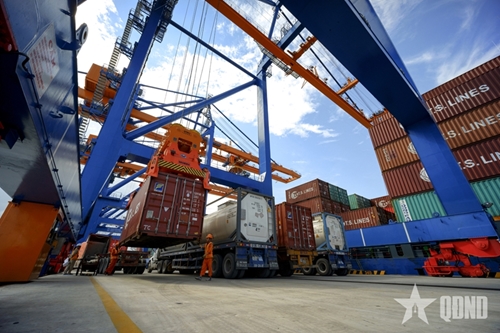Room for dialogue and negotiation
Reporter: The U.S. has just announced a 46% tariff on Vietnamese exports. What is the Ministry of Industry and Trade's assessment of this decision, sir?
Mr. Ta Hoang Linh: The Ministry of Industry and Trade regrets the U.S. decision to impose a 46% tariff Vietnamese exports to the country, effective from upcoming April 9. Vietnam and the U.S. have complementary economies; the export and trade structures of our two countries do not directly compete but instead support each other, aligning with each country's domestic needs.
    |
 |
|
Import-export operations at Nam Dinh Vu Port, Hai Phong City |
Vietnamese goods exported to the U.S. mainly compete with third-country products, not with American businesses. Moreover, Vietnamese exports help U.S. consumers access more affordable goods.
Vietnam currently applies an average Most-Favored-Nation (MFN) tariff of 9.4% on imported goods. Therefore, the proposed 46% retaliatory tariff by the U.S. lacks a scientific basis, is not really fair, and does not reflect Vietnam's goodwill and efforts to address the bilateral trade imbalance over the past period.
Reporter: What steps has the Ministry of Industry and Trade taken in response, sir?
Mr. Ta Hoang Linh: The Vietnamese Government, ministries, and sectors have worked to resolve various issues facing U.S. businesses operating in Vietnam. We've also issued decrees lowering MFN tariffs, benefiting 13 key U.S. export categories. Several U.S.-invested projects in Vietnam have received support and problem-solving assistance.
We understand that these new tariffs will remain in place until the U.S. determines that the perceived threats from trade deficits and unfair practices have been addressed or alleviated. That’s why we believe there is still room for discussions and negotiations between both parties to achieve a mutually beneficial outcome.
Immediately after the U.S. announced the new tariffs, Minister of Industry and Trade Nguyen Hong Dien sent an official note to the U.S. side requesting a delay in implementation to allow time for bilateral discussions and to seek reasonable solutions.
Maximizing benefits from 17 free trade agreements
Reporter: How might this policy affect Vietnam’s 2025 export growth targets, sir?
Mr. Ta Hoang Linh: For 2025, the Ministry of Industry and Trade aims for 12% export growth, targeting US$ 450 billion in total export turnover. This target is based on the expected recovery of the global economy and Vietnam’s effective use of its free trade agreements (FTAs). If no positive resolution is reached with the U.S., the tariffs could affect this growth target. However, this scenario was anticipated, and the Ministry has proposed a concrete action plan to the Government and issued recommendations to enterprises.
We forecast continued challenges for exports and emphasize the need for close coordination among ministries, agencies, and businesses to implement effective solutions and meet the 2025 export growth goal.
To realize this target, Vietnamese exporters must fully leverage the 17 signed FTAs, which span over 60 countries and territories, along with 70 bilateral cooperation mechanisms. Additionally, businesses must diversify export markets. While the U.S. accounts for 13% of global imports, it absorbs 30% of Vietnam’s exports, a strength, but also a potential vulnerability. Vietnam still has 87% of the global market left to explore, and the Ministry will continue to pursue new and high-potential markets.
Recommendations for Vietnamese exporters
Reporter: What solutions and recommendations does the of Industry and Trade have for export businesses, sir?
Mr. Ta Hoang Linh: Going forward, the Ministry Industry and Trade will continue to promote FTA negotiations with new markets such as the Middle East, Latin America, Central Asia, and emerging economies. We’ll also boost trade promotion activities, improve logistics infrastructure to reduce transportation costs, and enhance the competitiveness of Vietnamese goods.
The Ministry plans to expand Vietnam Trade Office network abroad to better support businesses in trade connections and export promotion. In the long run, Vietnam needs to restructure its economy, diversify markets, products, and supply chains to ensure fast and sustainable development.
For export businesses, we strongly recommend that they diversify export markets, take full advantage of both traditional and niche markets, and identify new potential destinations. In addition, they should improve product quality to meet technical, labor, and environmental standards required by export markets, thereby boosting competitiveness and reducing the risk of trade defense measures. On the other hand, product origin must be strictly controlled, especially regarding raw materials. They should also enhance trade defense capabilities, while staying informed about international trade policies to quickly adapt business strategies when needed.
Reporter: Thank you so much, sir!
Translated by Trung Thanh